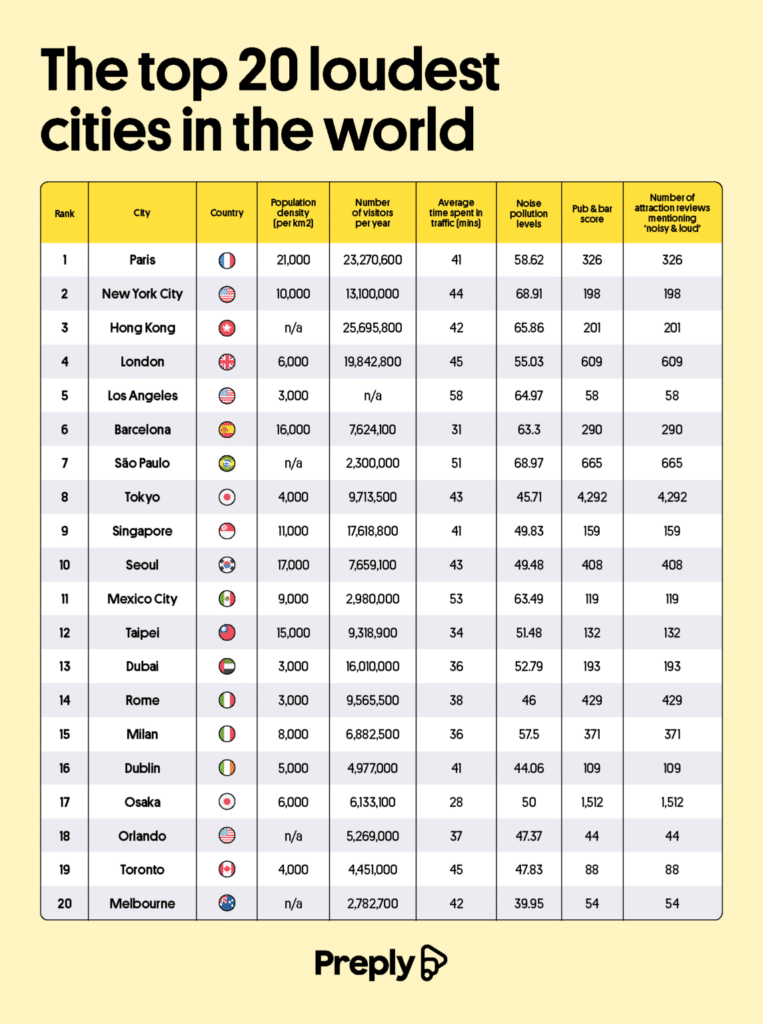By: Jacob Maslow
Noise pollution is an increasingly significant challenge in many of the world’s largest and densely populated cities. As urban centers continue to grow, so do the sources of noise that impact the well-being of residents. The hustle of daily life-traffic, construction, and the sheer number of people-contribute to the constant background noise that makes city living both exhilarating and exhausting. A study by Preply, an online Spanish classes platform, sheds light on the severity of this issue, comparing noise levels in global cities.

New York City: The City That Never Sleeps, and Rarely Quiets Down
New York City, often referred to as “The City That Never Sleeps,” consistently ranks among the world’s loudest cities. According to Preply’s study, New York is the second noisiest city globally, trailing only behind Paris. One might expect New York’s noise pollution levels to be less severe than those of Paris, given its lower population density and fewer tourists, but the reality is quite different.
The Role of Traffic in NYC’s Noise Problem
One of the main factors contributing to New York’s high noise levels is traffic. With millions of residents and visitors navigating the city daily, the constant hum of cars, buses, and taxis fills the air.
According to the study, New Yorkers spend an average of 44 minutes commuting. This daily grind adds to the overall soundscape, with vehicles honking, engines roaring, and sirens blaring. It’s not just the volume of traffic but the intensity of it that creates such a noisy environment. The constant stop-and-go, the crowded streets, and the honking that seems to never cease all blend into the cacophony that defines the city’s streets.
Tourist Attractions: A Magnet for Noise
New York’s attractions are another key contributor to the city’s noisy reputation. Millions of tourists flock to the city each year, eager to see iconic sights like Times Square, the Statue of Liberty, and Central Park. These popular destinations often become crowded, amplifying the noise. Preply notes that “New York is home to a lot of popular attractions that can get a little overcrowded at times, adding to the noise of the city.” The study highlights how pervasive the issue is by pointing out that “We found that an impressive number of reviews for attractions in NYC mentioned the words ‘noisy’ and ‘loud’.”
This bustling atmosphere is part of what makes New York such an exciting and vibrant destination, but it comes with this noise downside. While some may relish the lively energy, others may find it overwhelming.
The Health Effects of Noise Pollution
Noise pollution isn’t just annoying, it’s harmful. Long-term exposure to excessive noise can cause stress, high blood pressure, and even hearing loss. It can also disrupt sleep, leaving people fatigued and more anxious.
The constant noise wears on mental health, increasing stress and anxiety over time. But it’s not just people who are affected. Wildlife, such as birds and insects, also suffer. In noisy urban environments, animals struggle to adapt, and their natural behaviors are often disrupted, adding to the challenges of city life.
Global Efforts to Tackle Urban Noise Pollution
Cities worldwide are stepping up to address noise pollution. Places like Paris and Berlin are implementing noise radars and low-emission zones to reduce traffic noise. New York has introduced a comprehensive noise code to control noise from construction, nightlife, and street vendors. These initiatives are critical steps toward reducing the health impacts of excessive urban noise, marking a shift toward healthier, quieter living conditions.
As cities grow, so does the challenge of noise. New York, with its constant development and traffic, must continually adapt its noise management strategies. By learning from cities like Paris and Tokyo, New York can refine its policies and balance growth with noise reduction to create a more livable environment.
Conclusion
Noise pollution is a global challenge, affecting millions of city dwellers and wildlife alike. Managing this growing issue requires cities to innovate and enforce regulations. By doing so, cities like New York can help protect the well-being of residents while maintaining the vibrant energy that defines urban life.
Published by: Josh Tatunay

















